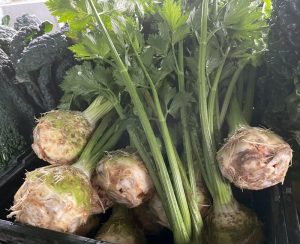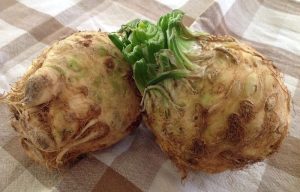Celeriac
Julie French, from the Montmorency Community Group, cooks with less popular or familiar veggies and fruit. Here she discusses how to use and cook celeriac. See her other articles in the right hand sidebar.
 One of the pleasures of the change of seasons is to see old veggie friends appear in the market stalls at the Eltham Farmers’ Market. A favourite of mine is the rough and knobbly celeriac root, which I queue up for at Silvertine Farm no matter the weather. Not the most attractive of vegetables, it doesn’t call out “eat me“, but it is tasty and worth adding to your winter repertoire. Celeriac is a variety of celery cultivated widely around the Mediterranean and has a long history – it was mentioned in the Iliad and Odyssey.
One of the pleasures of the change of seasons is to see old veggie friends appear in the market stalls at the Eltham Farmers’ Market. A favourite of mine is the rough and knobbly celeriac root, which I queue up for at Silvertine Farm no matter the weather. Not the most attractive of vegetables, it doesn’t call out “eat me“, but it is tasty and worth adding to your winter repertoire. Celeriac is a variety of celery cultivated widely around the Mediterranean and has a long history – it was mentioned in the Iliad and Odyssey.
Celeriac can be prepared and eaten in many ways and is a good alternative to potato, especially if you’re trying to cut back on carbohydrates. As well as being low in carbs and fat, it is high in fibre and a good source of vitamins B6, C and K. It also contains important minerals, such as phosphorus, potassium and manganese. Finally, it has been used in traditional Chinese medicine for its supposed anti-inflammatory qualities.
 All parts of the celeriac, can be used – including the skin if you scrub it really thoroughly. The bulb itself can be roasted, mashed, gratineed, used in fritters and tarts or used raw (as in the classic French rémoulade). The stems and leaves can be used in the same way you’d use celery.
All parts of the celeriac, can be used – including the skin if you scrub it really thoroughly. The bulb itself can be roasted, mashed, gratineed, used in fritters and tarts or used raw (as in the classic French rémoulade). The stems and leaves can be used in the same way you’d use celery.
A tip before you start: once peeled and cut, celeriac will discolour. This makes no difference to the flavour but, if you want it to look less grey, rub the peeled bulb with some lemon, or drop sliced/cut pieces into some acidulated water.
Things to do with celeriac:
- Substitute celeriac for potatoes to make chunky chips.
- Mash it on its own or add some potato to make a creamier mash (celeriac has a higher water content than potato).
- Peel, shave thin slices horizontally, pat dry and deep fry to make celeriac crisps.
- Make a gratin with thinly sliced celeriac – boil slices until just tender then arrange in a buttered dish, sprinkle each layer with grated parmesan, salt and pepper, pour over a little cream and top with parmesan, some dobs of butter and breadcrumbs. Bake at 200degC.
- Make a winter veggie bake with celeriac, pumpkin, Brussels sprouts, onion, tinned chopped tomatoes and whatever else you have to hand. Cook at 190degC till the veggies are tender, then top with some sliced haloumi drizzle with olive oil and bake for a further 15 minutes.
- Grate it and use it in fritters (see recipe below).
- Finely chop the stems to garnish soups.
- Add stalks, stems and skin to your vegetable stock pot.
- Make a salad such as a classic French céleri-rémoulade (see below).
Celeriac and potato cakes
1 large celeriac, peeled and grated
2 medium potatoes, peeled and grated
2 eggs
grated rind from a large lemon
2 tablespoons chopped parsley
salt and pepper
Put the celeriac into a clean tea towel and squeeze to remove as much water as you can. Place all the ingredients into a bowl and mix together well.
Heat a frying pan over medium heat, add a little oil and a knob of butter. When the butter is sizzling, add tablespoonfuls of the mixture (be careful not to crowd the pan) and cook for 2-3 minutes on each side, or until golden.
Serve with slices of smoked salmon or smoked trout and sour cream.
Céleri-rémoulade (from Jane Grigson’s Vegetable Book)
Cut one good sized celeriac into julienne (matchstick) lengths and mix with 200-250 ml good quality Dijon mustard flavoured mayonnaise. Decorate with chopped parsley.
